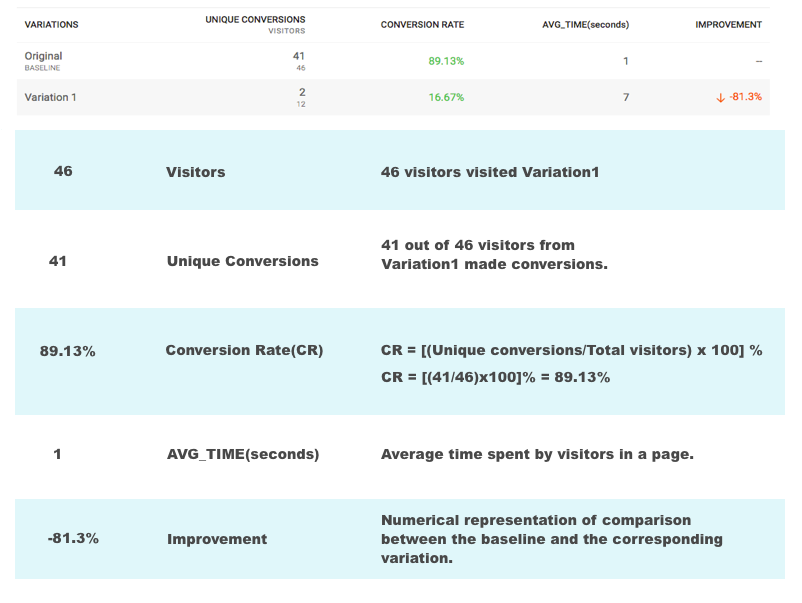Track time on Page Goal
Goals in A/B testing helps you learn your visitors’ behavior in the variations you create and gain insights to boost your site’s conversion rate.
At Freshmarketer, we provide a number of options in Goals which are imperative to the measurement of success rate. One such Goal which can be of utmost importance is Track time on Page.
You have a site in which you need to track the conversion rate based on the amount of time your visitors spend on the page, then Track time on Page goal is the one which you should choose.
When can it be used?
You can track visitors’ time on page in a specific page by setting it as a Goal in the A/B test experiment.
For example, let us assume Fashionista - a leading fashion blog, posts about all the latest trends in fashion industry. Fashionista now wants to check whether all its site’s visitors read the latest article posted on the blog’s landing page. This can be made possible by setting an A/B testing experiment using Freshmarketer with Track time on Page goal to Greater than 300 seconds on that page. Since a post might take approximately more than 5 minutes to read, if a visitor stays on the page for more than 300 seconds, then it is treated as a successful conversion
If the tab containing the page in which the experiment is running or shift between tabs and browsers is closed, the session gets reset automatically and the Track time on Page starts counting from 0 seconds.
How to set this goal in Freshmarketer?
Under Goals tab, click Add another goal button and choose Track time on Page goal from the list of options from the drop down list. You can set this goal as a primary goal for your experiment.
You can specify the time in the form of seconds ranging between 1 to any numerical value you prefer in the text area next to the specified operator Greater than.
In the Report section, data insights of all the conversion metrics for all goals will be present. You can see the insights for Track time on Page goal for your experiment.
In the above screenshot, a pictorial representation of derived insights in the form of a graph corresponding to Track time on Page goal is shown.
Below the graph, you can find the numerical representation of all the metrics associated with this goal for all the variations along with the original. The metrics associated with Track time on Page goal are explained below
How Freshmarketer computes AVG_TIME in the report?
This is calculated individually for variation(s) and also for an original. It is a numerical representation of the average time of all the sessions of all the visitors for a particular variation/original.
For example, if variation1 has 2 visitors, V1 having two sessions - 10 seconds and 15 seconds; V2 having 3 sessions - 2 seconds, 4 seconds and 6 seconds. Then to calculate AVG_TIME, the individual average time for each visitor is calculated.
V1 - (10+15) seconds/2 = 12.5 seconds
V2 - (2+4+6) seconds/3 = 4 seconds
Here, the denominator represents the number of sessions.
So the AVG_TIME for the variation1 is, (12.5+4)/2 = 8.25 seconds
Here, the denominator represents the number of visitors (V1 and V2).
How Freshmarketer is different from Google Analytics in terms of Session Duration?
Let us assume that a site has 4 pages - Page A, Page B, Page C and Page D. User enters Page A at 10:30:00 and then enters Page B at 10:30:10. Then the user moves to Page C at 10:30:40 and finally visits Page D at 10:30:50. Now, the user exits Page D at 10:31:00.
So the user’s duration of the Session is calculated by Google analytics by subtracting the timestamps, for example, (Time in Page B) – (time in Page A).
Page A - 10 seconds
Page B - 30 seconds
Page C - 10 seconds
Page D - 0 seconds
Google analytics calculated the final page’s duration as 0 seconds since there is no timestamp on the next page as the user went to another website or the user just closed the browser/ tab. So there is no reference to count the time. But the user spent 10 seconds there and there is no way to calculate the time – hence, it’s always 0.
And in Google analytics, for Single page sessions, the Session duration will always be 0, because there is no provision to move to other pages.
But in Freshmarketer, Session duration is calculated for single page sessions too for all visitors, which is the cumulative value of all the sessions of a visitor.
Technical Support



